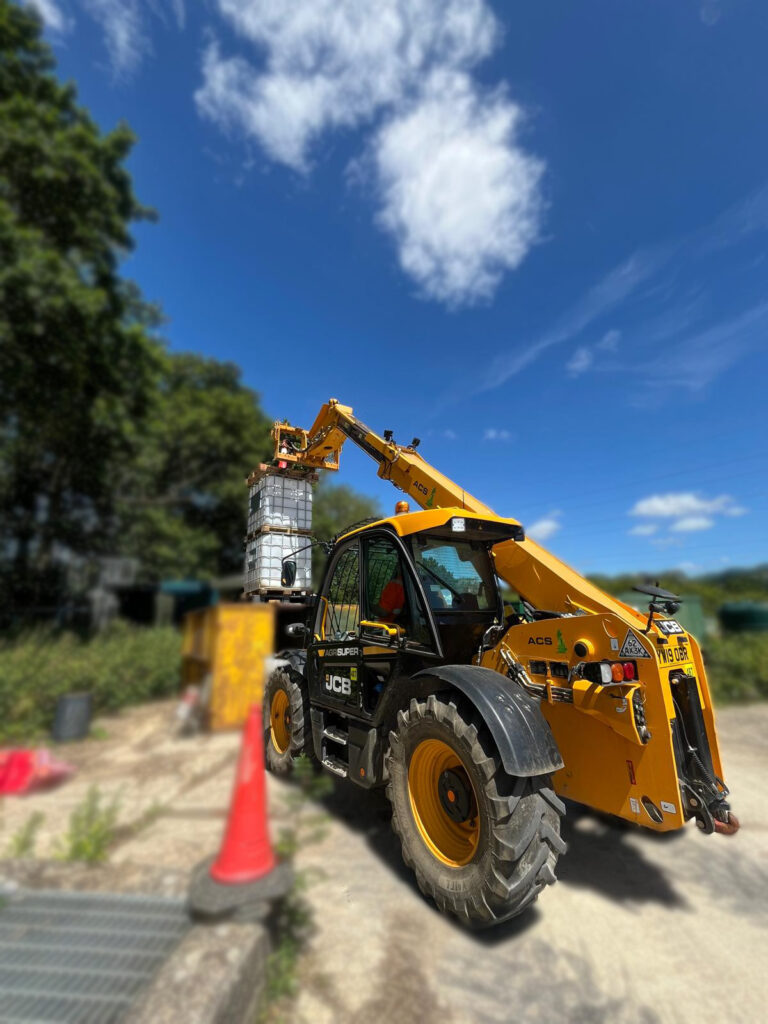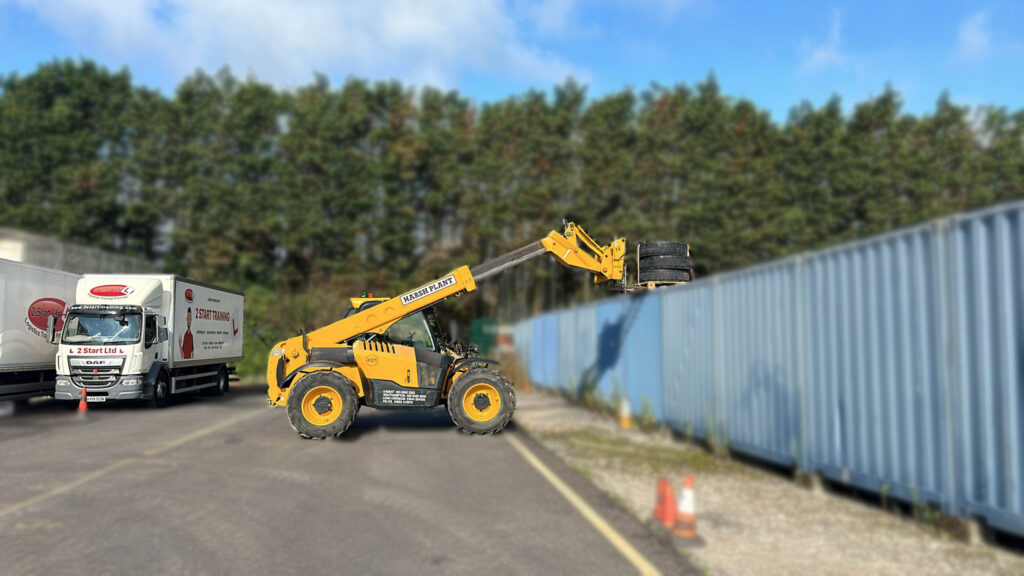A rough terrain telehandler can be defined as a vehicle that loads, moves, and unloads cargo. The Telehandler can be used on several terrain types. From uneven roads, to construction sites and hilly inclines. These types of vehicles are designed to work on “rougher terrains” hence the name. This machine type is also known as an all-terrain forklift, as well as a heavy-duty lift or a variable reach truck.
Whether you are a beginner, or an experienced operator, you can learn everything you need to know about rough terrain telehandlers, including the history, use cases and career expectations.
What is a telehandler?
A Rough Terrain Telehandler is a type of forklift. The key difference is that this classification of machinery can extend further for reach, whereas different types of Forklifts can extend vertically, but not as much horizontally, if at all! A telehandler also has a powerful engine to assist in working on different terrains. These rough terrain vehicles also have better stability, along with the “boom” giving them better extension.
This arm handles loads being moved. Attachments can range, most common being buckets, forks, towing hitch and hook.
2 start currently offer rough terrain courses for J1, J2 & J3.

What Modules are Covered?
Pre-operational checks
These are vital to ensure that the machinery is not damaged or faulty before being used to complete the work intended.
Maintenance checks
These are in place to keep these machines in best condition, helping with longevity.
Route planning and inspection
Helps to identify any obstructions, terrain changes or alternatives routes applicable to getting to the job site where the work must be completed.
Hazard mitigation
Understanding the hazards which could be apparent, and how to mitigate these, furthering the safety of the operator and other pedestrians.
These factors must always be considered and implemented before every use in your job role.
As an operator, you must also be aware of both the PUWER and the LOLER regulations.
PUWER
Provision and Use of Work Equipment Regulations (PUWER) considers the equipment being used for the work is in best condition.
It also states that equipment provided for work must only be used by individuals who have received “…adequate information, instruction and training.” This further includes information on what operators and businesses must do when taking into account working with telehandlers. This includes:
- Working conditions
- Maintenance log
- Requirements of the operator
- The Required Training necessary
- Risk prevention
- Relevant Personal Protective Equipment (PPE) provided
- Instructions regarding how to use the operating equipment Safely and Properly
LOLER
Lifting Operations and Lifting Equipment Regulations (LOLER) refers to the appropriate duties for the people of businesses which own, operate or control lifting equipment. Whether this be equipment owned, or rented, this regulation enforces the safe and proper planning of lifting by a capable person with the relevant training provided to them.

Both PUWER and LOLER are in place to affirm consistency in enforcing safety and highlighting the relevance of regular security procedures being in place, as well as the consequences of not adhering to these.
Benefits of a Telehandler
Larger Reach
One core benefit is that a Telehandler has a significantly larger reach. This boom can extend and retract while bearing a load too.
Versatility
Telehandlers are versatile, since they are designed for several terrain types. This makes transporting this machinery much easier. They can also work for a longer period.
Cost Effective
Telehandlers also assist in reducing labour costs and increasing productivity. This is because they can work on any ground type, making tricky work areas be a thing of the past.

Limitations
Instability
The large reach is also a disadvantage, as it can make the Telehandler unstable when operated by a less experienced operator. The boom acts as a “lever” and although the counterweights on the back of the vehicle do help, lifting capacity is reduced with more reach.
Overturning Issues
Relative to the instability point, this vehicle also can be prone to overturning.
Size
In most cases, telehandlers are much larger in size, which means they can’t be used indoors. This can be an issue if you are looking for machinery, such as a rough terrain vehicle, that can work and move indoors as well as outdoors.

History
Originally manufactured by JCB in 1977, the Telehandler was predominantly aimed at construction sites. Since then, there have been more variations and truck types for different scenarios.
What type of rough terrain vehicles are there?
There are several types of vehicles which can be considered as “rough terrain vehicles.” Rough Terrain Telehandlers are used regularly.
What are the Certification Requirements for Telehandlers?
So, do you need a licence to drive a telehandler? There is no such thing as a rough terrain licence!
You need a valid rough terrain certification to drive the telehandler you would like to operate.
Age Requirements
If you are over 17 years old, you are permitted to obtain a telehandler certification.

How long does a Telehandler certification last?
The 3–5-year window from date of attaining your certification is when you will need to complete refresher training. This will keep your certificate valid and keep you compliant in the use of the Telehandler certification you obtained, plus up to date with latest changes.
Why do you need to complete training?
Like with any heavy machinery, if not handled correctly, lots of problems can emerge.
Certification is something that must not be ignored. If you are an employer or business, you must insist in all operators having an in-date certification, along with up-to-date telehandler training to remain compliant.
The Ramifications Due To A Lack of Checks
There are always consequences when it comes to a lack of planning, checking and risk mitigating. These checks are enforced to enhance the safety of workers, while also reaffirming as to why operators and businesses must keep their machinery in good operational condition.
Can I drive a forklift with a Telehandler Certification?
No, Telehandlers and Forklifts, although similar, are very different types of machinery which require differing levels of training. If you have a forklift certification, you will still need to complete separate Rough Terrain training so that you are awarded your telehandler certification.
Can Telehandlers Be Driven On The Road?
For a short period of time, these machines can be driven on the road. Although, it must be fully registered as a vehicle beforehand. This also includes insurance for the rough terrain vehicle. You must register the vehicle as “agricultural” if it is used in this environment, such as moving hay bales or fertiliser, for example.
Salary Expectations
As a Telehandler operator, there could be several additional job roles you have. However, The average annual salary for a Telehandler operator is between £24,000 and £37,000.
The training for a telehandler can be adapted for other construction machinery. For example, utilising the skills from a telehandler and implementing them within other forklift training (such as Counterbalance Forklifts) can aid in your learning.
So, you must complete a Rough Terrain Course with an accredited provider so that you are being trained to a nationally recognised standard, which ensures your learning of the responsibilities for rough terrain telehandlers is sufficient.
All of 2 Start’s Rough Terrain courses are accredited by the Independent Training Standards Scheme & Register (ITSSAR).










